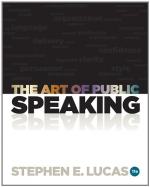Do not forget that. Restlessness is not expression. A great many useless movements will only take the attention of the audience from what you are saying. A widely-noted man introduced the speaker of the evening one Sunday lately to a New York audience. The only thing remembered about that introductory speech is that the speaker played nervously with the covering of the table as he talked. We naturally watch moving objects. A janitor putting down a window can take the attention of the hearers from Mr. Roosevelt. By making a few movements at one side of the stage a chorus girl may draw the interest of the spectators from a big scene between the “leads.” When our forefathers lived in caves they had to watch moving objects, for movements meant danger. We have not yet overcome the habit. Advertisers have taken advantage of it—witness the moving electric light signs in any city. A shrewd speaker will respect this law and conserve the attention of his audience by eliminating all unnecessary movements.
Gesture Should either be Simultaneous with or Precede the Words—not Follow Them
Lady Macbeth says: “Bear welcome in your eye, your hand, your tongue.” Reverse this order and you get comedy. Say, “There he goes,” pointing at him after you have finished your words, and see if the result is not comical.
Do Not Make Short, Jerky Movements
Some speakers seem to be imitating a waiter who has failed to get a tip. Let your movements be easy, and from the shoulder, as a rule, rather than from the elbow. But do not go to the other extreme and make too many flowing motions—that savors of the lackadaisical.
Put a little “punch” and life into your gestures. You can not, however, do this mechanically. The audience will detect it if you do. They may not know just what is wrong, but the gesture will have a false appearance to them.
Facial Expression is Important
Have you ever stopped in front of a Broadway theater and looked at the photographs of the cast? Notice the row of chorus girls who are supposed to be expressing fear. Their attitudes are so mechanical that the attempt is ridiculous. Notice the picture of the “star” expressing the same emotion: his muscles are drawn, his eyebrows lifted, he shrinks, and fear shines through his eyes. That actor felt fear when the photograph was taken. The chorus girls felt that it was time for a rarebit, and more nearly expressed that emotion than they did fear. Incidentally, that is one reason why they stay in the chorus.
The movements of the facial muscles may mean a great deal more than the movements of the hand. The man who sits in a dejected heap with a look of despair on his face is expressing his thoughts and feelings just as effectively as the man who is waving his arms and shouting from the back of a dray wagon. The eye has been called the window of the soul. Through it shines the light of our thoughts and feelings.




